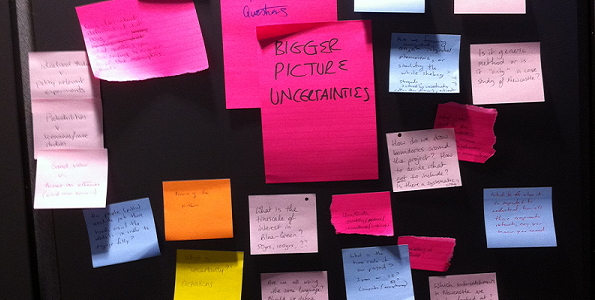
November 20, 2013, by Blue-Green team
Decision Making Under Uncertainty; the LWEC approach
Decision-making under uncertainty; reporting back from LWEC Uncertainty conference (Emily Lawson).
Several of the Blue-Green Cities team attended the Living With Environmental (LWEC) annual conference ‘Decision-making in the twilight of uncertainty’ on the 19th November in Birmingham. The conference aimed to “demonstrate different approaches to addressing uncertainty around decision-making and how we can make better use of the evidence we have such as:
- co-designing research to fill evidence gaps,
- making research more discoverable,
- translating research into clearer formats,
- providing tools that work for users,
- examining the communication of scientific uncertainty “ (taken from the LWEC website).
This coincided well with the in-house Blue-Green Cities Uncertainty Workshop which we held on 11th November, which got us all thinking in more detail about the types of uncertainty in each of the work packages, how these might propagate through the research structure, and how we might best communicate these to stakeholders (after first finding out what level of uncertainty the stakeholders are interested in, which may, at first pass, not be what we were originally thinking of providing!)
Here are some of the key points I noted down from the LWEC Uncertainty conference that are specifically relevant to flood risk management and communicating uncertainty.
- Using scenarios for future projections; owing to future uncertainty in human (socio-economics) and natural (e.g. climate change and future rainfall events) processes, creating a set of scenarios to model is a favoured method which can account for some of the variability in our “knowledge” of the future. These scenarios can then be updated when we have more ground data which will illustrate which scenario is most likely.
- Decision-makers DO make choices under severe uncertainty; the example given looked at evacuation. During a flood event, the decision to evacuate needs to be made before the maximum flood inundation extent is certain, otherwise evacuation may become impossible.
- Communicating risk is a tricky business and multiple events are often not expected; for instance, if you are flooded by a 1 in 100 year event in one year, you might not expect to be flooded the following year by another event (e.g. 1 in 125 year event). There is a very low probability of such multiple events happening BUT it is not impossible. But how best can flood risk professionals communicate this?
- Visualisation can help with uncertainty communication; such as the excellent LWEC Report Cards which show three levels of uncertainty in the natural processes; high confidence in what could happen, medium and low confidence.

What could happen to water resources by the 2050s? Water Climate Change Impacts Report Card from LWEC 2013
- Do people care what type of water they are flooded by? If your house is inundated do you really care whether this was from river water or rainfall? I think it is important to inform people of the type of flooding as it may impact on how they deal with the aftermath, e.g. groundwater flooding sticks around for a long time as the ground is saturated and so surface water reduction via infiltration will be exceedingly slow.
- The flood warning systems, e.g. Environment Agency flood alerts, are mainly for fluvial (river) flooding; so how can we warn people of pluvial (surface water) flooding from intense rainfall if the path of the storm is uncertain and only known with confidence a few hours before an expected event (does this give enough time for warnings to be heeded and people to prepare?)
- Do not underestimate the public’s understanding of uncertainty but do not create unnecessary confusion by using technical/scientific language, e.g. the word “enhance” can be viewed by many people as something good, but scientists often just mean “increase”
Watch the on-demand highlights on the on the ESKTN You Tube channel.
No comments yet, fill out a comment to be the first

Leave a Reply